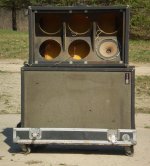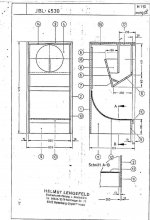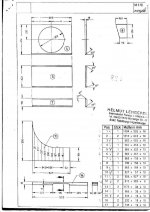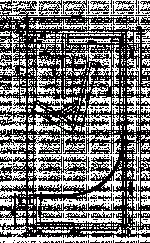Is anyone on here familiar with the design of guitar speaker whose cross-section is shown here?
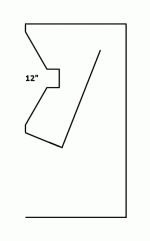
I built one of these a long time ago, following a design in "Sounds" weekly music paper, published in the UK, sometime roughly around 1977 to 1979.
As the diagram shows, the front of the speaker is open, and the rear works into a compression chamber that vents into a constant width, increasing height horn.
I don't have the speaker or the original article now, but it worked very well indeed, great tone and very efficient. Any information gratefully received!
Rear loaded folded horn is another name that these things seem to go by.

I built one of these a long time ago, following a design in "Sounds" weekly music paper, published in the UK, sometime roughly around 1977 to 1979.
As the diagram shows, the front of the speaker is open, and the rear works into a compression chamber that vents into a constant width, increasing height horn.
I don't have the speaker or the original article now, but it worked very well indeed, great tone and very efficient. Any information gratefully received!
Rear loaded folded horn is another name that these things seem to go by.
Last edited:
Years later I had a West African Djembe drum, which reminded me of it in some ways. Wikipedia says this:
"The djembe can produce a wide variety of sounds, making it one of the most versatile drums. The drum is very loud, allowing it to be heard clearly as a solo instrument over a large percussion ensemble."
Which sounds just pretty much ideal for a guitar speaker too!
"The djembe can produce a wide variety of sounds, making it one of the most versatile drums. The drum is very loud, allowing it to be heard clearly as a solo instrument over a large percussion ensemble."
Which sounds just pretty much ideal for a guitar speaker too!
Nope, haven't seen one of those, but it looks plausible. Don't try to make it any smaller though, from my work with transmission lines, I think the horn length needs to be about 3 feet, minimum, for a guitar.
I think a Djembe is a bass reflex, or a box with transmission line. The taper isn't great enough to act as a horn. Cool drums, though.
Speaking of speakers and drums, check these out:
Products
I think a Djembe is a bass reflex, or a box with transmission line. The taper isn't great enough to act as a horn. Cool drums, though.
Speaking of speakers and drums, check these out:
Products
Sunn also made cabinet of such of a design.
The Sunn 215.
I was just digging out My old guitar rig and I am starting to get it back together with some new drivers.
Right now I have some old Altec Lansing's in the 215 and I used to have some 400/800 watt MCM Select's in it.
I have a set of some Pyle PPA10's that I will be installing in the 610.

jer
The Sunn 215.
I was just digging out My old guitar rig and I am starting to get it back together with some new drivers.
Right now I have some old Altec Lansing's in the 215 and I used to have some 400/800 watt MCM Select's in it.
I have a set of some Pyle PPA10's that I will be installing in the 610.

jer
Attachments
Hi, and thanks for all of your responses so far, certainly helping my thinking about this, it's been a long time since I designed any speakers, and I built this one with with just about no knowledge at all of how it was really working.
Keriwena, point taken about the djembe. I also once had a "goblet drum" where the tube was a completely straight cylinder, no flare at all. The sound was quite different, a more rigidly defined resonance I thought, at the time. Of course there were other differences between the two.
My knowledge of acoustics is still pretty ropey really, wasted too much time on this electrickery stuff. I do understand the idea of a ported reflex or acoustic guitar body as consisting of box with compliance (electrical analogue capacitor), then port/hole with inertance (electrical analogue inductor).
Could you give me any pointers towards likely areas of study to understand more of what happens as the port changes from a straight constant section tube, to one dimensional linear taper (like my speaker diagram ie area increasing linearly along length), to two dimensional or conical taper, and on towards a "true" horn?
I'm definitely not ready for boundary element methods yet, and in any case I suspect that that would give me numbers without much understanding.
Loudthump, interesting what you were saying about there often being a null somewhere in the upper bass, from what I remember of the sound of my cab that might well have been going on, it definitely got a thunder and lightning sort of sound.
Keriwena, point taken about the djembe. I also once had a "goblet drum" where the tube was a completely straight cylinder, no flare at all. The sound was quite different, a more rigidly defined resonance I thought, at the time. Of course there were other differences between the two.
My knowledge of acoustics is still pretty ropey really, wasted too much time on this electrickery stuff. I do understand the idea of a ported reflex or acoustic guitar body as consisting of box with compliance (electrical analogue capacitor), then port/hole with inertance (electrical analogue inductor).
Could you give me any pointers towards likely areas of study to understand more of what happens as the port changes from a straight constant section tube, to one dimensional linear taper (like my speaker diagram ie area increasing linearly along length), to two dimensional or conical taper, and on towards a "true" horn?
I'm definitely not ready for boundary element methods yet, and in any case I suspect that that would give me numbers without much understanding.
Loudthump, interesting what you were saying about there often being a null somewhere in the upper bass, from what I remember of the sound of my cab that might well have been going on, it definitely got a thunder and lightning sort of sound.
On the one hand, since commercial cabinets are seldom "designed", and are mostly "the smallest box we could fit all the speakers in", it's not that hard to DIY 'better' enclosures.
On the other hand, the Thiele/Small stuff and all the programs based on it don't take into account two features of guitar cabinets that don't apply to hifi cabs - the speakers and cabinets are non-linear. That is, the T/S parameters of the speakers change when you crank them to levels that will compete with a drummer, and the cabinets themselves become "translucent". That is, they leak a lot of sound through the walls, no matter how thick you make them. Well, within reason... I suppose you could use cinderblocks, but then you'd need a forklift instead of a hand truck to load in at a gig.
Still, the basic math applies, it's just you can't take the calculated sizes as gospel. It does help, though, to know if you should make the box bigger, longer, or make the port smaller. I find Augspurger's TLwrx easy to use, and playing with it will answer your questions about taper, etc, rather neatly.
Other toys you might want include PE's WT3 to measure the T/S parameters, something like HOLMimpulse to measure the finished speakers, and an SM57 - not a typical test mic, but it won't cry when you crank your amp.
On the other hand, the Thiele/Small stuff and all the programs based on it don't take into account two features of guitar cabinets that don't apply to hifi cabs - the speakers and cabinets are non-linear. That is, the T/S parameters of the speakers change when you crank them to levels that will compete with a drummer, and the cabinets themselves become "translucent". That is, they leak a lot of sound through the walls, no matter how thick you make them. Well, within reason... I suppose you could use cinderblocks, but then you'd need a forklift instead of a hand truck to load in at a gig.
Still, the basic math applies, it's just you can't take the calculated sizes as gospel. It does help, though, to know if you should make the box bigger, longer, or make the port smaller. I find Augspurger's TLwrx easy to use, and playing with it will answer your questions about taper, etc, rather neatly.
Other toys you might want include PE's WT3 to measure the T/S parameters, something like HOLMimpulse to measure the finished speakers, and an SM57 - not a typical test mic, but it won't cry when you crank your amp.
I am not sure of the date on the 610.
So I will look and see if I can find the markings.
I am guessing around 70 or so maybe.
I got it in 76 when I was just 13 with the Concert Lead Head.
I think the amp head had a date of 72.
I paid $400 for it used back then and I think I paid $200 for the 215 with the Anvil Road Case with no drivers.
I still have the original Speaker frames for the 610 but the magnets are much too weak to invest in a re-coning job.
I have re-coned those things three time already.
Sadly that head is long gone, But I do have two Concert Slave amps that I normally run on the stack.
The 215 cabinet if I remember correctly has a date of 68 I have only been inside of it like 3 or for times since I got it.
I think Acoustic used a similar style of design as well.
I have only experienced two of those systems so far.
One was a guitar rig that I played on one night when they had just come out,again I was just 14!! he,he,he
And the other one was used by the bass player in Yasgar's down in Florida when I did the sound for them.
jer
So I will look and see if I can find the markings.
I am guessing around 70 or so maybe.
I got it in 76 when I was just 13 with the Concert Lead Head.
I think the amp head had a date of 72.
I paid $400 for it used back then and I think I paid $200 for the 215 with the Anvil Road Case with no drivers.
I still have the original Speaker frames for the 610 but the magnets are much too weak to invest in a re-coning job.
I have re-coned those things three time already.
Sadly that head is long gone, But I do have two Concert Slave amps that I normally run on the stack.
The 215 cabinet if I remember correctly has a date of 68 I have only been inside of it like 3 or for times since I got it.
I think Acoustic used a similar style of design as well.
I have only experienced two of those systems so far.
One was a guitar rig that I played on one night when they had just come out,again I was just 14!! he,he,he
And the other one was used by the bass player in Yasgar's down in Florida when I did the sound for them.
jer
Last edited:
Look to nature
Considering the range of acoustic nuance originating from the animal kingdom I would suggest looking there for some ideas that could be adapted. If I were going to experiment with a speaker system I would look into curved surfaces in the inside and perhaps the spiral shapes found on a speaker design at this site. Don't recall what is was called but it was huge! Too big! But consider too the human ear canal. small as it is, frequency coupling to the eardrum is most efficient. The biggest problem with that approach however will relate to applications of calculus and engineering principles- Of which I'm short on.
Another consideration relates to the frequency range of the guitar. Will there be a benefit in a two way speaker system? Can that benefit be realized better with a crossover network and second speakers?
Just some thoughts,
Ccat.
Considering the range of acoustic nuance originating from the animal kingdom I would suggest looking there for some ideas that could be adapted. If I were going to experiment with a speaker system I would look into curved surfaces in the inside and perhaps the spiral shapes found on a speaker design at this site. Don't recall what is was called but it was huge! Too big! But consider too the human ear canal. small as it is, frequency coupling to the eardrum is most efficient. The biggest problem with that approach however will relate to applications of calculus and engineering principles- Of which I'm short on.
Another consideration relates to the frequency range of the guitar. Will there be a benefit in a two way speaker system? Can that benefit be realized better with a crossover network and second speakers?
Just some thoughts,
Ccat.
Thanks for those JBL diagrams Roflynn. They show a more sophisticated design than the one I built, which would fit with their intended use, ie essentially hifi, as opposed to electric guitar.
That said, the JBLs are beautiful things, and I can see how they were quite probably the starting point for the design of the one I built. Really nice to see those pictures.
For anyone interested in the JBL 4530s, the jbl site still has some info up at https://www.jblpro.com/pub/obsolete/Low_Frequency_Enclosures2.pdf
Thanks again,
Simon
That said, the JBLs are beautiful things, and I can see how they were quite probably the starting point for the design of the one I built. Really nice to see those pictures.
For anyone interested in the JBL 4530s, the jbl site still has some info up at https://www.jblpro.com/pub/obsolete/Low_Frequency_Enclosures2.pdf
Thanks again,
Simon
- Status
- This old topic is closed. If you want to reopen this topic, contact a moderator using the "Report Post" button.
- Home
- Live Sound
- Instruments and Amps
- Horn loaded reflex guitar speaker box
